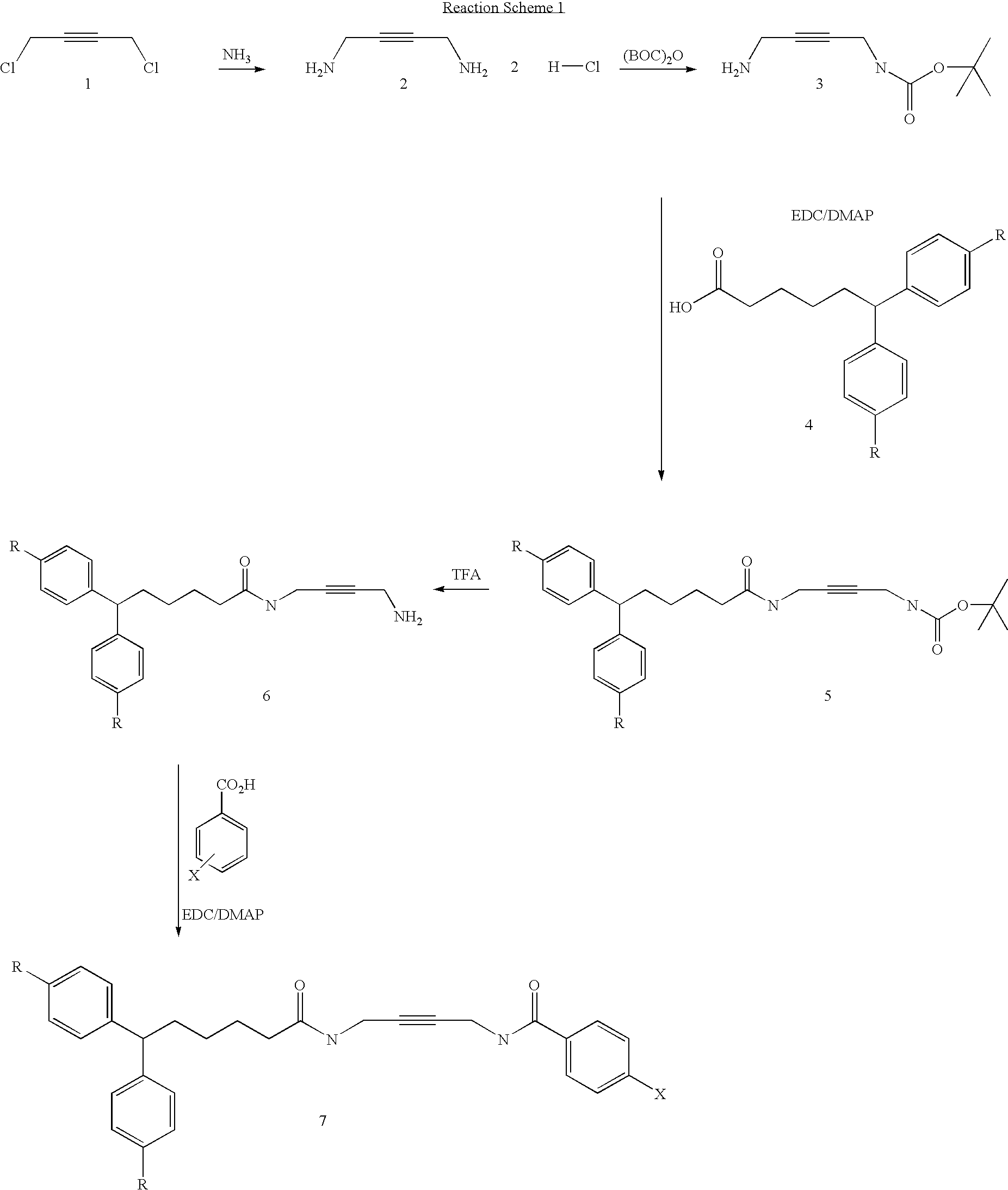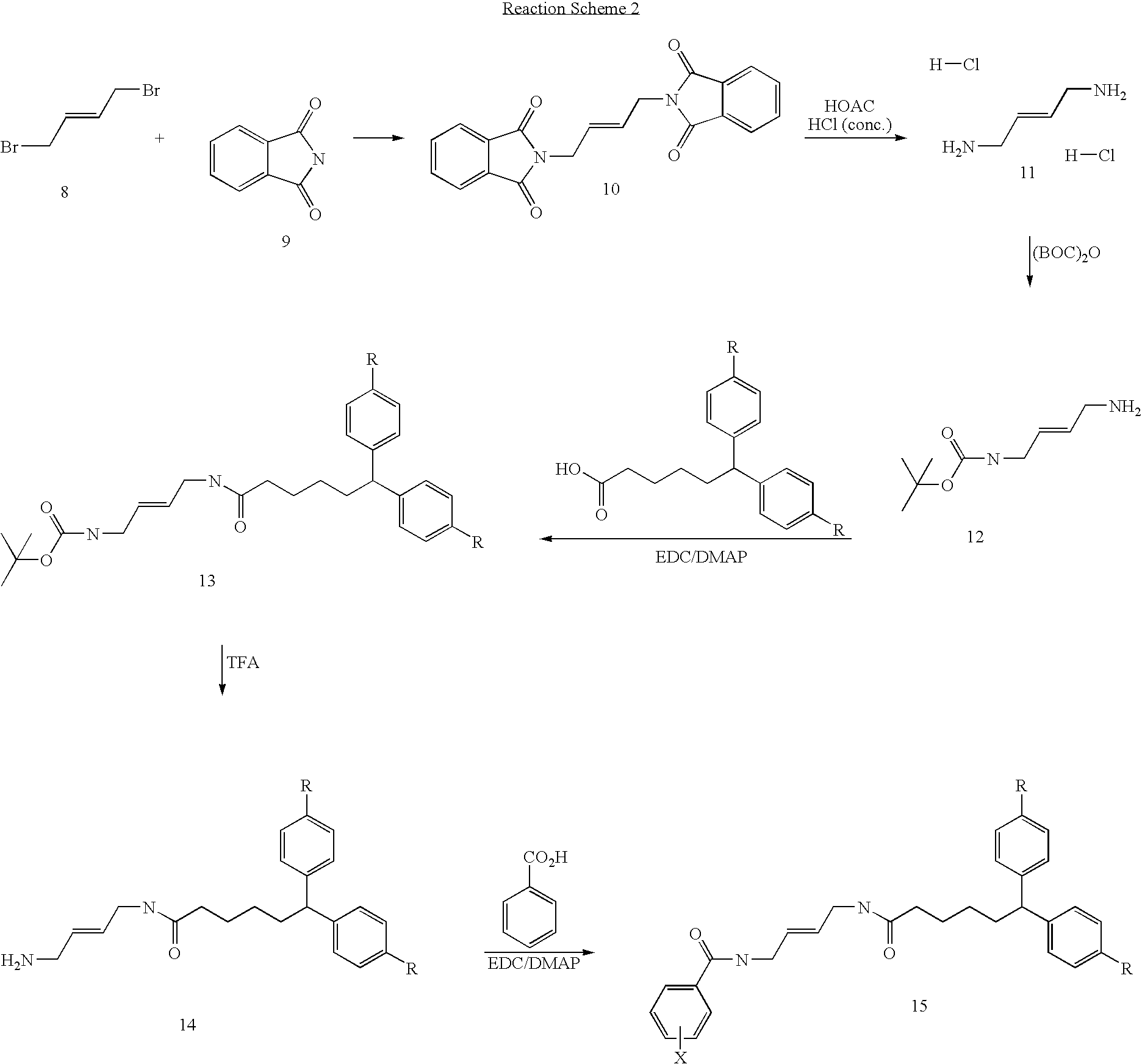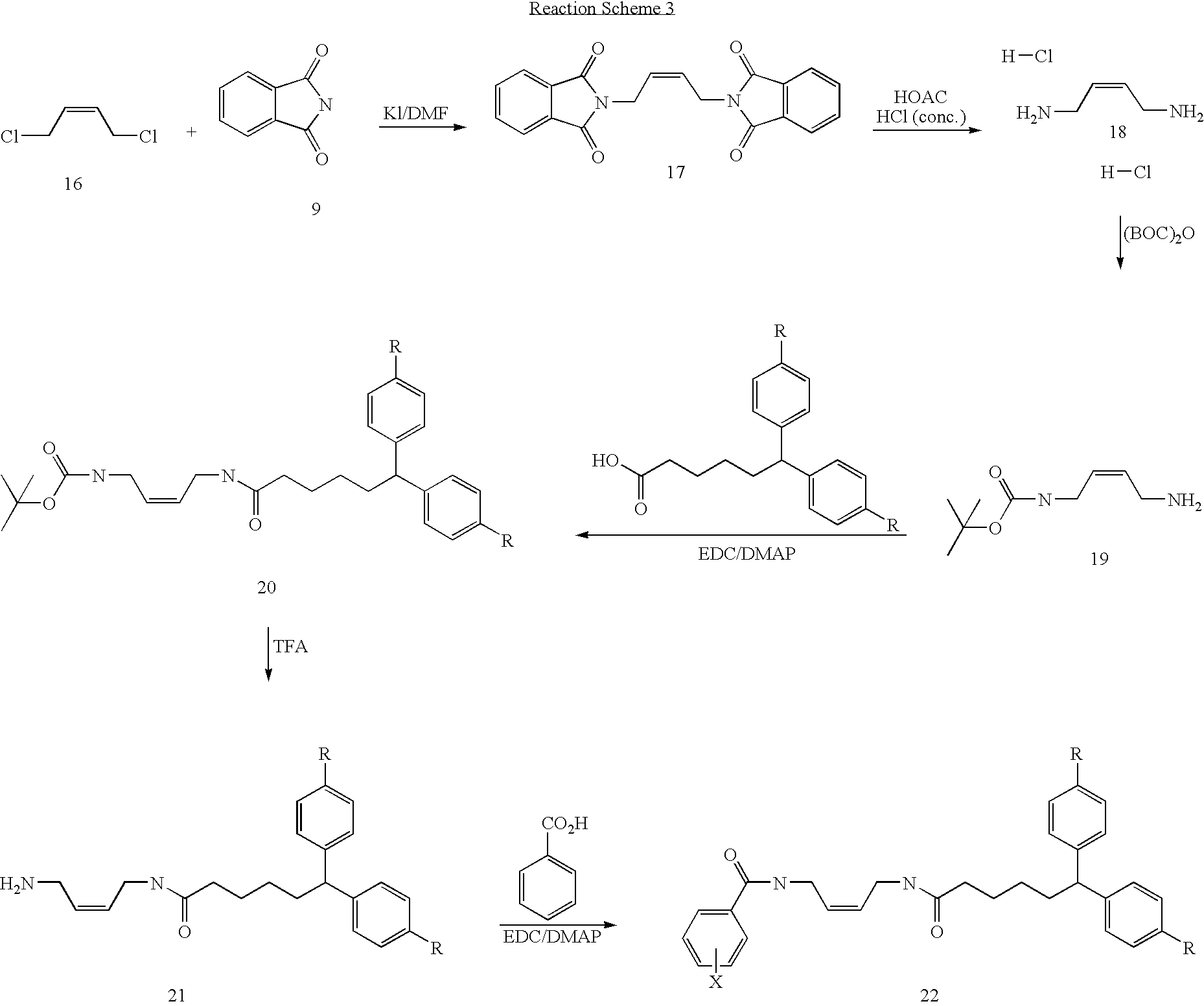Diamine calcium channel blockers
a calcium channel blocker and diamine technology, applied in the direction of biocide, drug composition, metabolic disorder, etc., can solve the problem of sedation preventing the continuation of therapy
- Summary
- Abstract
- Description
- Claims
- Application Information
AI Technical Summary
Benefits of technology
Problems solved by technology
Method used
Image
Examples
example 1
Synthesis of N-{4-[6,6-bis-(4-fluoro-phenyl)-hexanoylamino]-but-2-ynyl}-4-chloro-benzamide (P28)
[0099]
A. Synthesis of But-2-yne-1,4-diamine
[0100]
[0101]But-2-yne-1,4-dichloride (5 g,40.67 mmol) and ammonium hydroxide (30%, 180 ml) were mixed and resulting solution stirred at room temperature overnight. The ammonia was then evaporated and the residue dissolved in water twice and evaporated. 1N HCl (20 ml) was added and evaporated to dryness. To the residue acetone was added and precipitate was filtered off and dried to give 9.5 g of desired crude product.
B. Synthesis of (4-Amino-but-2-ynyl)-carbamic acid tert-butyl ester
[0102]
[0103]But-2-yne-1,4-diamine dihydrochloride (5.0 g, 31.84 mmol) was suspended in 10% TEA / MeOH solution (70 ml). To the above suspension TEA (8 ml) was added. A solution of di-tert-butyldicarbonate (2.31 g, 10.61 mmol) in methanol (5 ml) was added drop-wise to the vigorously stirred mixture. The reaction mixture was refluxed for 3 h, and stirred at room temperatur...
example 2
Synthesis of N-{4-[6,6-Bis-(4-fluoro-phenyl)-hexanoylamino]-but-2-enyl}-4-fluoro-benzamide (P10)
[0109]
A. Synthesis of (E)-1,4-Diaminobut-2-ene dihydrochloride
[0110]
[0111]Potassium phathalimide (20 g, 108 mmol) was added in portions over 2 h to a stirred solution of (E)-1,4-dibromobut-2-ene (10.7 g, 50 mmol) in DMF (100 ml) at room temperature. The mixture was stirred for a further 3 days at this temperature, then poured into water (100 ml), and the mixture was extracted with dichloromethane (5×100 ml). The organic extracts were dried, filtered and concentrated in vacuo to leave DMF (ca. 30 ml), and a white solid, which was filtered off and washed with ether (3×10 ml) to give (E)-1,4-diphathalimidobut-2-ene (15.5 g, 91% yield).
B. Synthesis of (E)-1,4-diaminobut-2-ene dihydrochloride
[0112]
[0113](E)-1,4-diphthalimidobut-2-ene (15.7 g, 45 mmol) was suspended in glacial acetic acid (160 ml), and conc. HCl (160 ml) was added. The mixture was heated at reflux until all the (E)-1,4-diphthal...
example 3
Synthesis of (Z)-N-{4-[6,6-Bis-(4-fluoro-phenyl)-hexanoylamino]-but-2-enyl}-4-choloro-benzamide (P8)
[0121]
A. Synthesis of (Z)-6,6-Bis-(4-fluoro-phenyl)-hexanoic acid (4-amino-but-2-enyl)-amide
[0122]
[0123](Z)-{4-[6,6-Bis-(4-fluoro-phenyl)-hexanoylamino]-but-2-enyl}-carbamic acid tert-butyl ester (1.6 g, 4.3 mmol) was dissolved in dry CH2Cl2 (50 ml) followed by addition of TFA (20 ml). The resulting solution was stirred at room temperature for 2 hrs. The solution was concentrated under reduced pressure. The resulting residue was dissolved in water (20 ml) and pH of the solution was adjusted to 10. The water phase was extracted with CH2Cl2 (100 ml), and dried over magnesium sulfate. The solvent was evaporated under reduced pressure to give the desired product in almost quantitative yield.
B. Synthesis of Final Product
[0124]To a solution of 6,6-Bis-(4-fluoro-phenyl)-hexanoic acid (4-amino-but-2-enyl)-amide (0.33 g, 0.89 mmol) in dry CH2Cl2 (30 ml) was added 4-fluoroobenzoic acid (0.14 g,...
PUM
| Property | Measurement | Unit |
|---|---|---|
| frequencies | aaaaa | aaaaa |
| pH | aaaaa | aaaaa |
| frequency | aaaaa | aaaaa |
Abstract
Description
Claims
Application Information
 Login to View More
Login to View More - R&D
- Intellectual Property
- Life Sciences
- Materials
- Tech Scout
- Unparalleled Data Quality
- Higher Quality Content
- 60% Fewer Hallucinations
Browse by: Latest US Patents, China's latest patents, Technical Efficacy Thesaurus, Application Domain, Technology Topic, Popular Technical Reports.
© 2025 PatSnap. All rights reserved.Legal|Privacy policy|Modern Slavery Act Transparency Statement|Sitemap|About US| Contact US: help@patsnap.com



